Discover the top 20 AI marketing tools utilized by today’s biggest companies. Learn how teams are leveraging artificial intelligence to accelerate their growth.
Google, IBM, and Airbnb, among others, are using AI marketing tools to gain a competitive advantage. I’ve discovered and listed some of the greatest AI advertising tools on the market today.
The development of AI software has irreversibly altered the ancient art of marketing. Hundreds of these tools have appeared in recent years, making it difficult to determine which will deliver the most value.
It’s critical to focus on what you want your AI marketing tool to do, so let’s begin by defining what artificial intelligence is particularly beneficial for and what it can do for your company.
What is the use of AI in marketing?
Marketing in 2024 will be all about data – information on competitors, industry trends, and what your consumers (and future buyers) are saying about your product. There is a lot of material available; however, it is difficult to find manually. AI improves this procedure significantly. It accomplishes what would be difficult to accomplish by hand quickly and at scale.
Positive and negative product reviews can be collected using techniques such as sentiment analysis. Competitor intelligence may keep you informed about what your competitors are doing. Better targeting may increase the ROI of your marketing initiatives. There are also AI-powered systems that can produce innovative text for you, allowing you to keep up with the internet’s never-ending need for content (SEO optimization).
You will almost certainly utilize more than one AI-powered software solution. Indeed, most data manipulation technologies today leverage machine learning and automation to deliver spectacular outcomes at scale. In this list of the best AI-driven applications and platforms, I’ll describe what each one does, what its merits are, and any restrictions it may have.
20 best AI marketing tools to help your business grow in 2024
Here are 20 AI marketing tools you should use in 2024:
- Jasper AI (for copywriting)
- Lexica Art (for blog thumbnails)
- Surfer SEO (for SEO content writing)
- Content at Scale (for generating SEO blog posts)
- Originality AI (for AI content detection)
- Writer.com (content writing for teams)
- Undetectable AI (for rewriting AI content)
- FullStory (for digital experiences)
- Zapier (for automating tasks)
- Hemingway app (for content editing)
- Chatfuel (for chatbots)
- Grammarly (for content editing)
- Albert.ai (for digital advertising)
- Headlime (for landing pages)
- Userbot.ai (conversation management)
- Browse AI (for scarping web pages)
- Algolia (for search and recommendation APIs)
- PhotoRoom (for removing image backgrounds)
- Reply.io’s AI Sales Email Assistant (for email replies)
- Brand24 (for media monitoring)
Let’s take a closer look at each one.
1. Jasper AI (for copywriting)
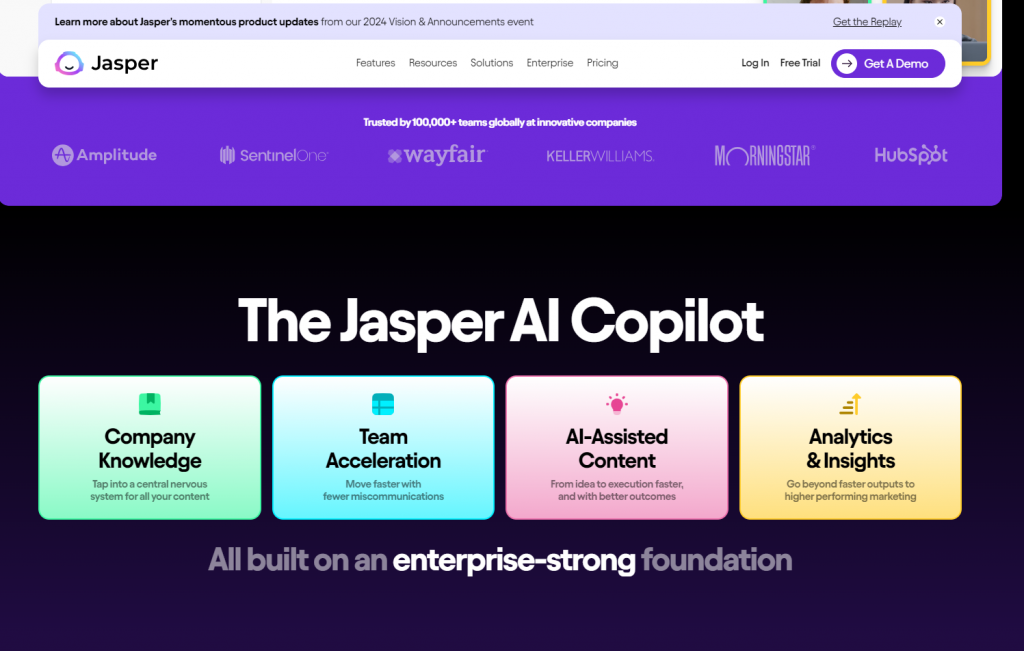
The creators of Jasper, the most well-known of the AI-powered copywriting systems, suddenly became victims of their own success. After they had over 350,000 users, Marvel sent them a cease-and-desist letter. Their AI was originally known as Jarvis, after Tony Stark’s (AKA Iron Man) virtual assistant. As a result, Jasper was reborn.
This human writer must hesitantly admit that Jasper is incredibly adept at writing text in a variety of tones and styles on any topic you can throw at it. According to its designers, it has “read” 10% of the internet. How well does Jasper function? I requested Jasper to write 40 words about AI in business automation using a free trial. It produced the following results:
AI is the next stage in corporate automation. AI had helped to improve corporate procedures. AI may be applied to a company’s business processes to boost efficiency, reduce costs, and improve customer service.
This is a good start, but you still need human interaction to understand the flow of the material, and there is some repetition. Jasper’s natural language processing is arguably best viewed as a tool for creating early manuscripts for human copywriters to improve later.
Jasper can produce text for email campaigns, product descriptions for ecommerce products, blog posts, and landing page copy, among other things.
It includes an easy-to-use interface, is economical to deploy, and will undoubtedly speed up the content development process. Jasper, which has over 5,000 5-star product evaluations, will not transform you into Tolstoy, but it will maintain those important SEO page scores high.
2. Lexica Art (for blog thumbnails)
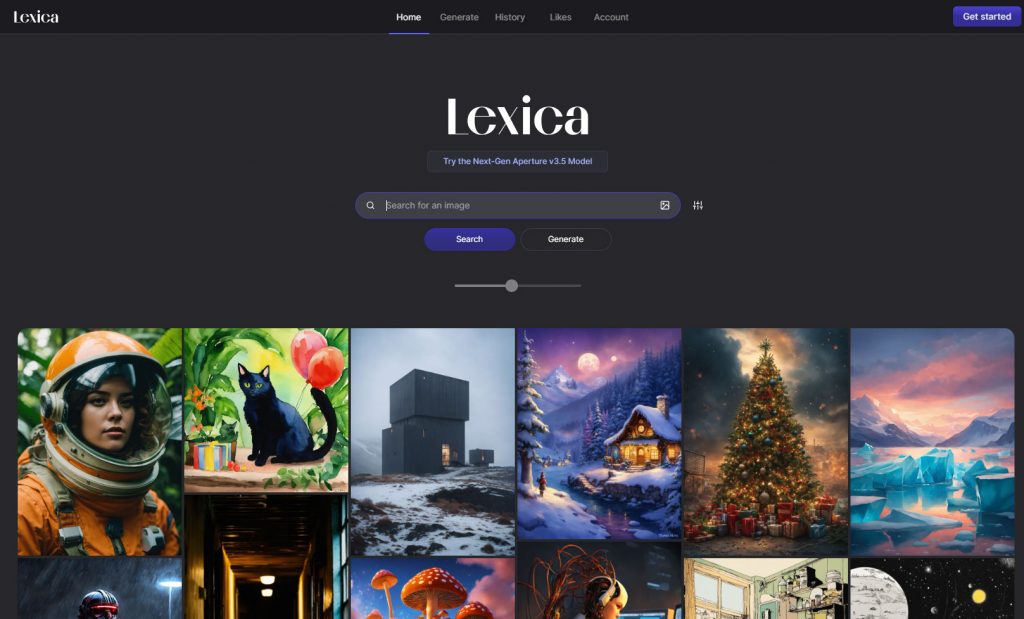
Lexica Art is a top-notch AI image generator, and it’s one of the best I’ve seen. It produces some of the most realistic AI graphics and can generate marketing material for nearly any purpose. I’ve utilized this AI-powered generative tool to generate blog thumbnail photos for my SEO (search engine optimization) customers. There are many prompts you may utilize and keep so that all of the images it creates are “on brand” with your brand requirements. Some businesses even utilize it for social media posts.
If you want to get away from using stock photos for your blog thumbnails, this is a tool you should certainly look into.
3. Surfer SEO (for content writing)

Surfer SEO is a content optimization tool that assists you in creating material for search engine ranking—an important aim for any content strategy. While you’re working, Surfer analyzes and ranks your material based on keyword density, readability, length, header use, and other factors that help content rank higher.
To begin using Surfer SEO, select your website, topic, and target audience. The algorithm will then provide you with actionable insights by identifying top-ranking keywords, recommending a content outline structure, and even defining picture density for your post. Surfer SEO includes its own text editor, so you may work directly on it or copy-paste for rapid inspection. The SEO of your work will improve in real time as you modify it.
Integrations with other content marketing technologies such as Jasper, WordPress, Google Docs, and others are available. Surfer SEO guarantees to meet your organic growth goals for Google search, and businesses who have used their services include FedEx, Shopify, Quantas, and Viacom.
4. Content at Scale (for generating SEO blog posts)

I’ve been playing with Content at Scale for the past few months, and I must say, I’m rather impressed. This is one of the few AI-authoring tools that I’ve used that passes AI detectors. When I use this program to write an essay and then run it through an AI detector, it generally comes out at least 70% human-written, which is extremely good.
The platform is still in its early stages, and the user interface can be glitchy. However, the material it creates is among the finest I’ve seen in terms of AI content development. It isn’t as versatile as Surfer in terms of labeling H2 and H3 headers in your articles, but the actual material it creates is of greater quality than Surfer and even Jasper. If you want to produce SEO blog content, I highly recommend trying with this tool. Of course, the final document should always be reviewed by a real person.
5. Originality AI (for AI content detection)
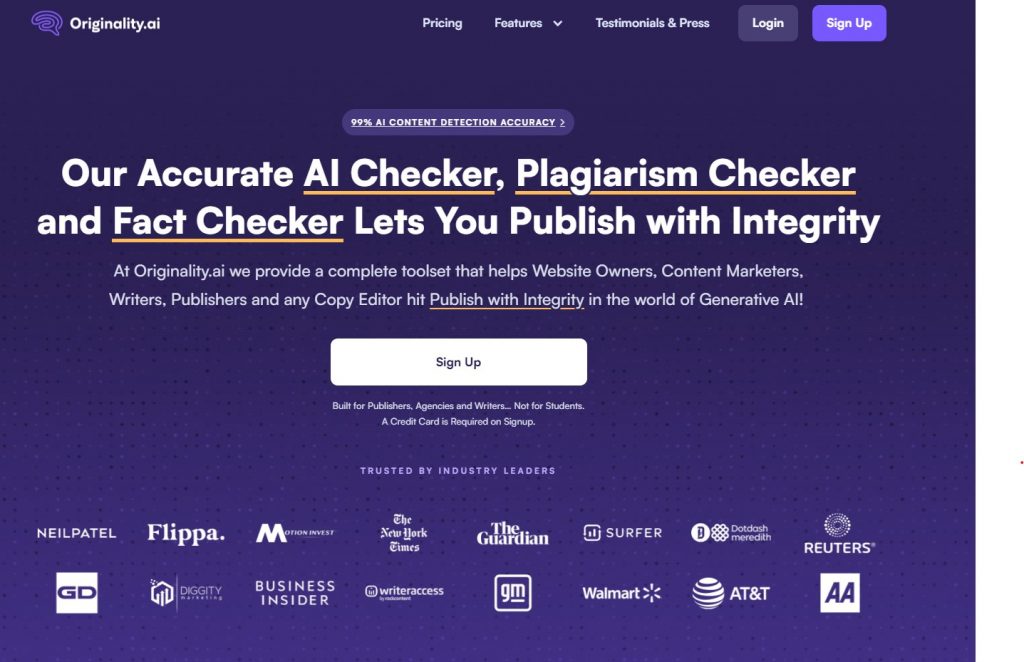
Originality AI is a content detection and plagiarism tool. These days, I run practically every piece of material via this program to ensure it has been produced by a human. Of course, I’m not going to run genuine human writing through it. But, in general, I’ll run AI-generated material from a service like Content at Scale through this to double-check which sections require development.
This is also a useful tool to use if you’re dealing with freelance writers and want to ensure they’re not utilizing ChatGPT to create enormous amounts of material. Take these detectors with a grain of salt, of course. There have been complaints of it incorrectly mistaking human writing for AI writing. However, out of the majority of AI content detectors available, I found this one to be one of the finest.
6. Writer (content writing for teams)
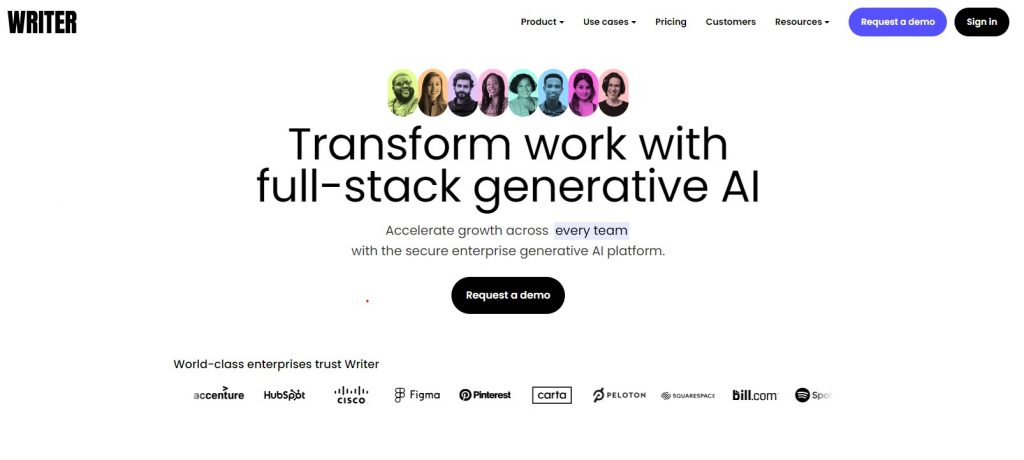
First of all, the writer has a high-value URL, which suggests that they have big plans. Their platform is positioned as a writer’s helper for marketing teams. Writer is a collaborative efficiency tool that turbocharges some of the functionality of a typical text editor, like Word.
Autocorrect, autocomplete, grammar and clarity checks, and frequently used snippets to put in are among the features. A range of intelligence tools, including a database of recognized language (essential for IT, legal, and financial organizations), is also available to help preserve house style. Their AI is kind, staying in the background offering recommendations rather than rewriting entire paragraphs.
When you have a virtual or hybrid workforce that works with little in-person supervision, this AI writer might offer you with the assurance you need that your writing stays professional and correct across all usage. Deloitte, Accenture, Twitter, and Vistaprint are among the clients.
7. Undetectable AI (for rewriting AI content)
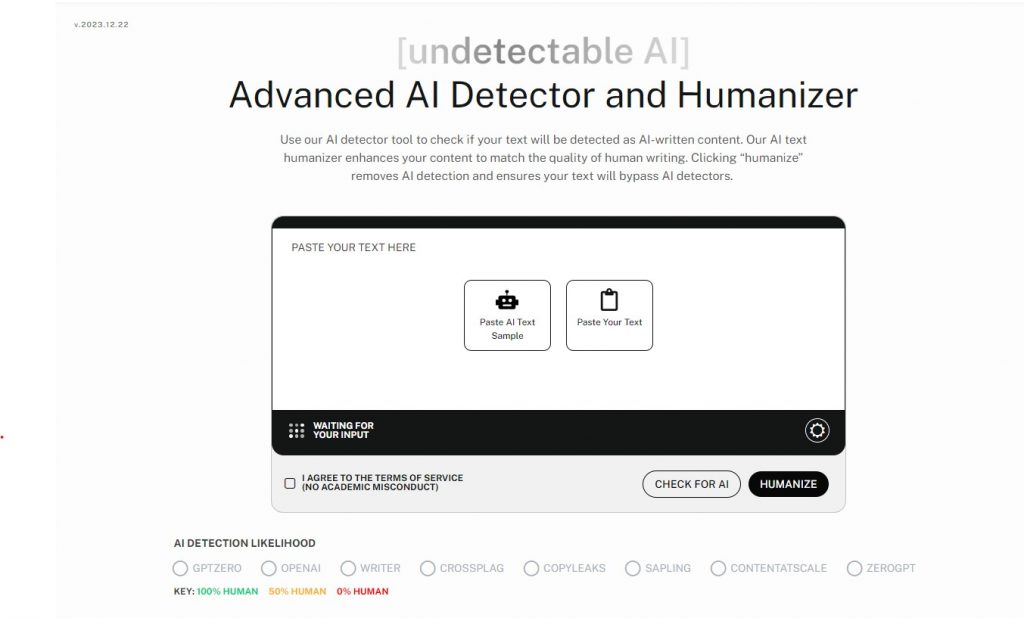
Undetectable AI is a comparable AI content detector to Originality AI. What defines this one is its ability to rewrite AI generated material from ChatGPT to sound human. I tested this by writing a paragraph of text in ChatGPT, rewriting it using Undetectable AI, and then double-checking it with Originality AI. Surprisingly, it performs a decent job.
Again, these AI detectors and rewriters should be treated with caution. This program will occasionally rewrite things that don’t make complete sense. Or it will purposefully make grammatical errors. As a result, you should still read everything it creates to ensure there are no mistakes.
8. Fullstory (for digital experiences)
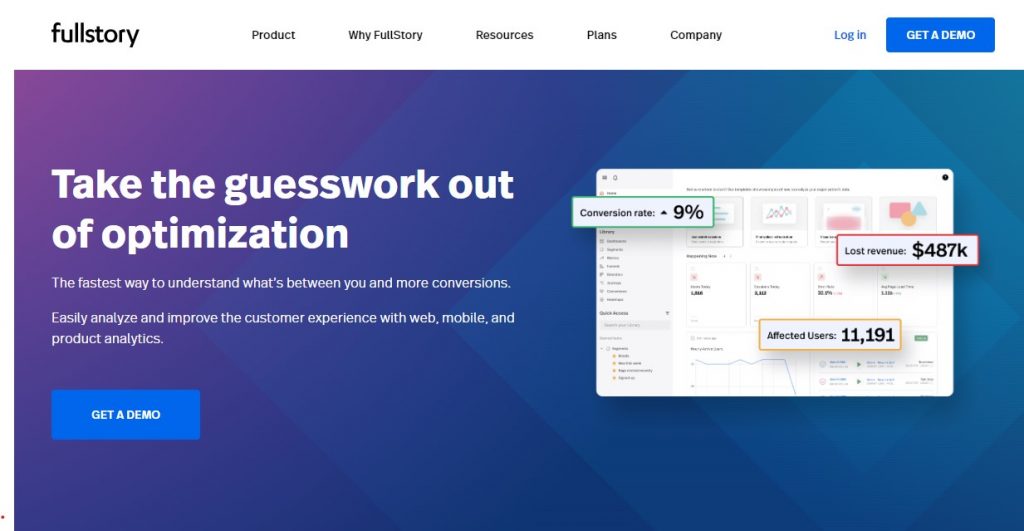
Fullstory defines digital experience as the path a site user takes from their initial visit to conversion (or discard). They emphasize the important point that you may learn a lot from the unexpected actions of users that could not have been predicted.
To achieve this degree of understanding, Fullstory uses AI to track every mouse motion, click, and page visit along a visitor’s trip in order to generate their “story.” This may then be compared to the accounts of thousands of other visitors to get insight. Fullstory uses AI automation’s processing capacity and scalability to uncover opportunities and faults far faster than any human observer could.
Fullstory claims customers will save money, retain more clients, and greatly enhance the UX of their site. GAP, Zipcar, Icelandair, and Forbes are among their current clients.
9. Zapier (for automating tasks)
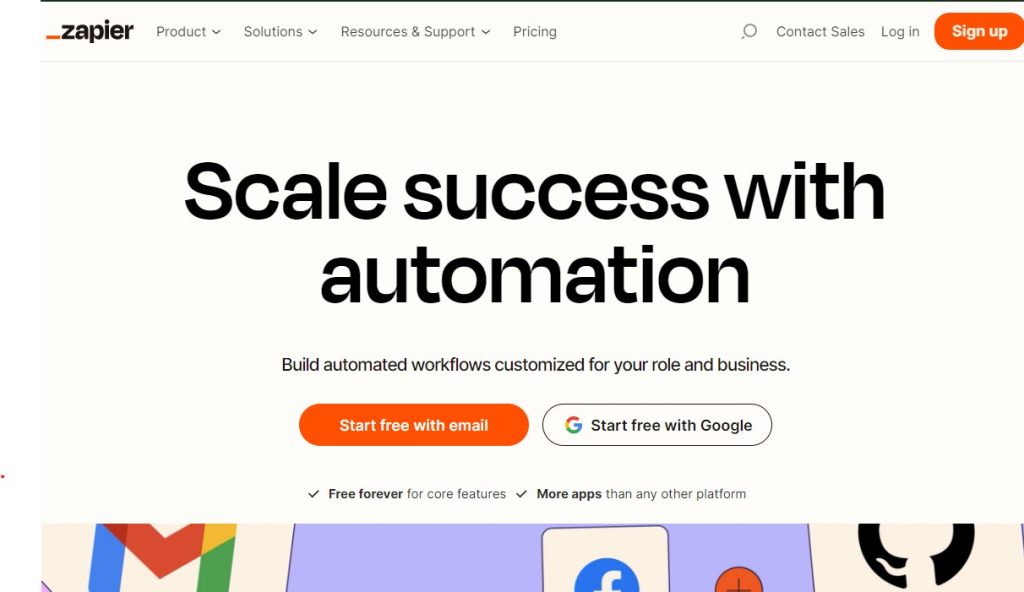
Zapier is the Lego of technology stack and process integration. You may use it to create connections and marketing automations between hundreds of different systems, saving time, increasing efficiency, minimizing repetitive operations, and saving money. You create customized workflows to connect actions in one system to automated operations in another or more. Each time, the relevant data is retrieved from the correct location.
These automations may be created without coding, and templates are available to help. Zapier calls its automations zaps, and it now has over 3,000 integrations. You may even construct branching processes based on logical criteria.
Behind the scenes, AI is understanding signals that activate operations at a pace and efficiency that no human team could match. Clients love how much time these zaps save them. There is also great assistance, such as a blog, webinars, an online no-code community, and Zapier University for training.
10. Hemingway App (for content editing)

Even if you just utilize human writers to develop your text, AI may assist in editing it for optimum readability and clarity. Hemingway, named after a renowned sparing writer, emphasizes features of “poor” style such as overlong sentences, passive voice, and excessive adverb use.
Hemingway also assigns a reading score based on US academic grades. Grade 9 or below is deemed optimal for reaching the greatest number of people. It’s quite simple to use: simply copy and paste your content into the online app and press return.
Best of all, it’s completely free! Ben and Adam Long designed the app in the style of their favorite author. Although a $20 edition with PDF exports, offline usability, and immediate publish capabilities is available, the free version is still quite helpful.
However, a perfectly optimized Hemingway article may feel overly basic for other reasons, such as annual reports, white papers, opinion pieces, and other sorts of writing where personal style trumps plain readability.
11. Chatfuel (for chatbots)

Chatbots are here to stay, whether they are useful AI helpers or an annoyance. Of course, the utility of a chatbot is determined on how it is built, which is where Chatfuel comes in. Rather than purchasing an off-the-shelf solution, the platform lets you design your own virtual identity using a simple drag-and-drop interface.
Chatfuel’s bots are incredibly adept at comprehending even misspelled or non-grammatical comments, whether you’re trying to replace a boring FAQ page or push potential leads down the funnel by giving discount vouchers. The AI here does extensive linguistic processing and can readily identify keywords that elicit relevant and useful answers.
They’re an official partner of Meta (previously Facebook), which should give you some peace of mind knowing their AI is top-notch.
12. Grammarly (for content editing)

Grammarly, like Hemingway, will examine your text for ways to enhance it. Unlike Hemingway, it makes fewer assumptions about style and instead emphasizes established norms of syntax and language.
Grammarly allows you to use it while working in a variety of apps, including Gmail, Word, Twitter, Facebook, and others. Its AI will spot faults and recommend corrections, which you may accept or reject. Grammarly can detect superfluous words and inconsistencies in style and give alternative word choices, going beyond simple grammar and punctuation.
It works by highlighting and color-coding flaws or possible changes (much like Hemingway) and has been highlighted in prestigious newspapers such as the Wall Street Journal, New York Times, and Forbes.
13. Albert.ai (for digital advertising)
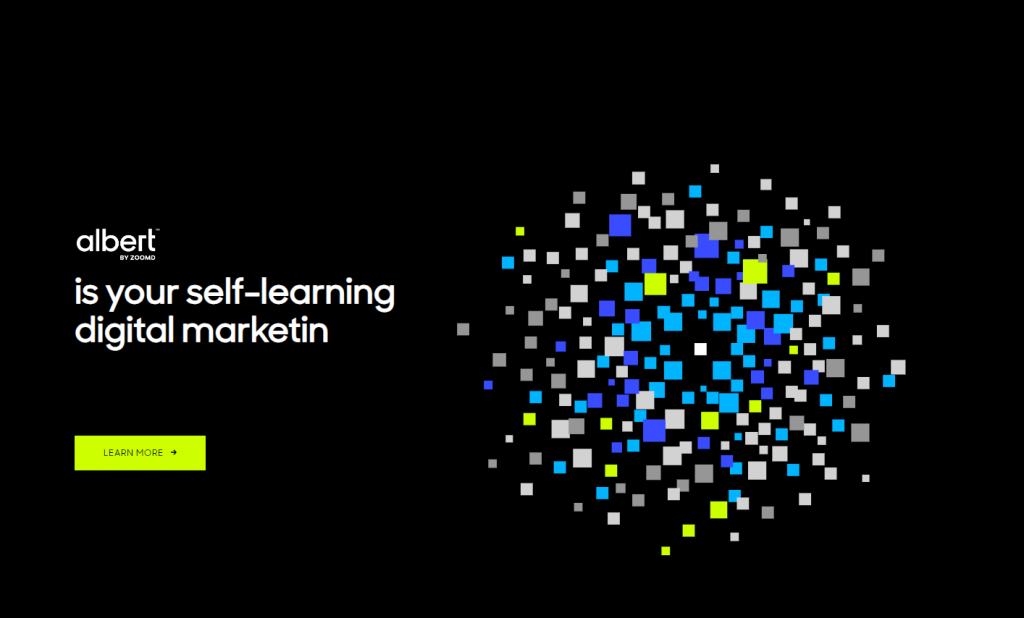
Advertising is essentially hit-or-miss, or was before the advent of AI. Albert scales personalization and optimization of ad content across social media and paid search platforms like Facebook, YouTube, Google Ads, Bing, and others. Albert refers to their process as “data-powered creativity,” and CEO Om Shani believes in harnessing artificial intelligence and automation to free up human creatives to create ads that connect on a human level.
Albert.ai serves as a testing and tuning laboratory for campaigns designed to capitalize on previously undiscovered channel opportunities, unanticipated demographics, or new markets. It contributes to making ad campaigns more relevant and less wasteful.
Crabtree & Evelyn, Telenor, and Harley Davidson are among Albert’s supporters. The latter saw a five-fold rise in site traffic and a staggering 2,930% increase in monthly leads.
14. Headlime (for landing pages)
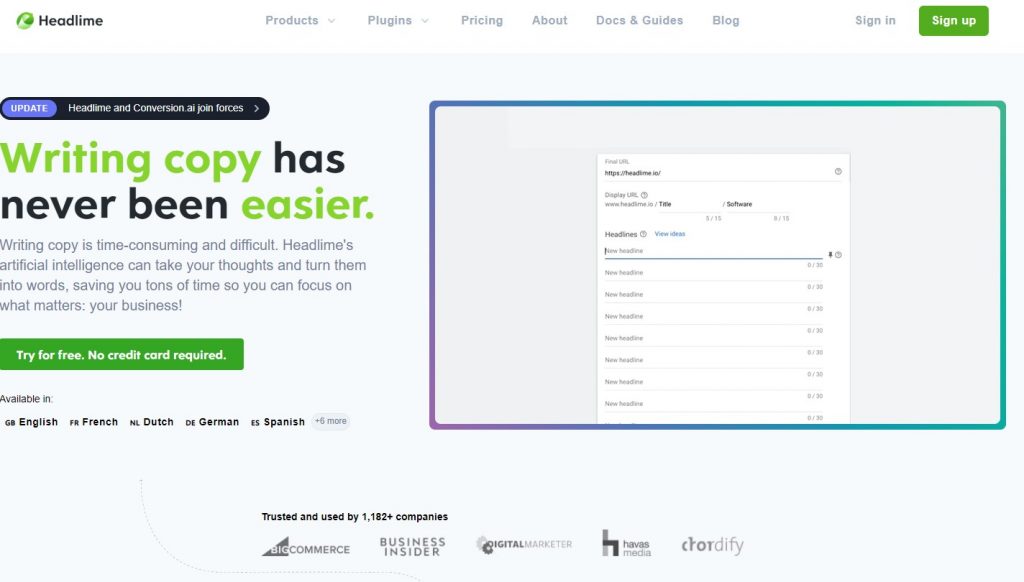
Since the landing page serves as the online equivalent of a shop, it is crucial. Headlime is an AI-powered content-creation system that aims to master the art of the landing page.
Headlime utilizes machine learning to assist anticipate and finish words you enter, possibly saving substantial time. It is powered by the deep learning skills of GPT-3 from OpenAI. It generates high-performing subject lines, reduces word count, and can compose copy in a variety of tones and languages.
It can produce blog material like Jasper, but it’s also integrated with a basic landing page builder, so you don’t have to copy-paste all the time. Above all, it is always focused on the goal at hand – improving time on page and conversions. You could have a worldwide landing page up and running in no time with over 1,700 copy templates in 11 languages.
15. Userbot.ai (for conversation management)
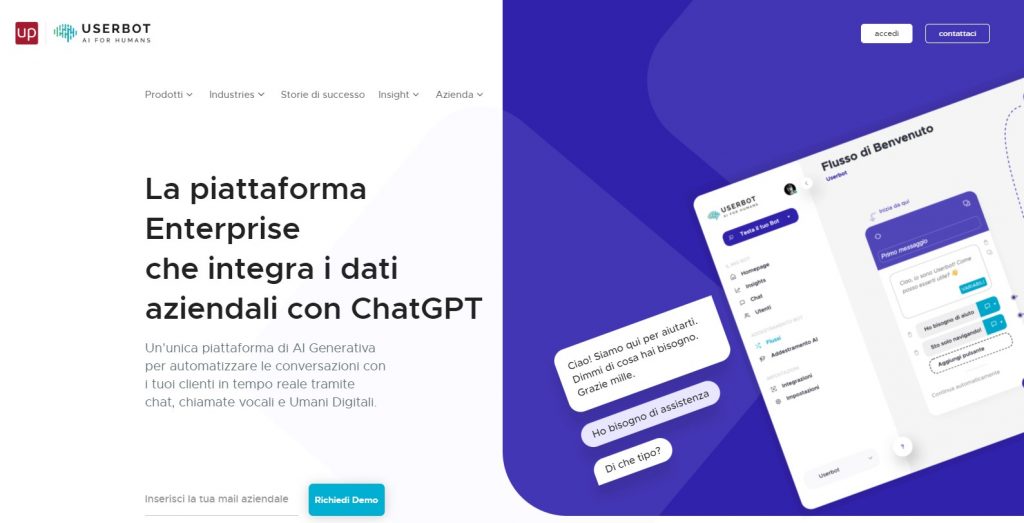
Userbot may appear to be simply another chatbot at first glance, but it is far more intelligent than that. When Userbot is unable to comprehend a customer’s question, it transfers control to a human operator while continuing to watch and learn from the remainder of the interaction. Userbot then applies what it has learned to refine and include the new user inquiry into its repertory.
As a result, Userbot should grow more intuitive and successful over time, but you may still need to rely on human operators when you initially introduce it. When I asked it, “Who are your top clients?” it was unable to produce a relevant response. For the record, Aboca, SSG, and Vivactis Group are among them.
The system generates relevant customer data that you can use to evaluate the efficiency of your sales force or customer care department (it also connects with several major CRM platforms).
16. Browse AI (for scraping web pages)
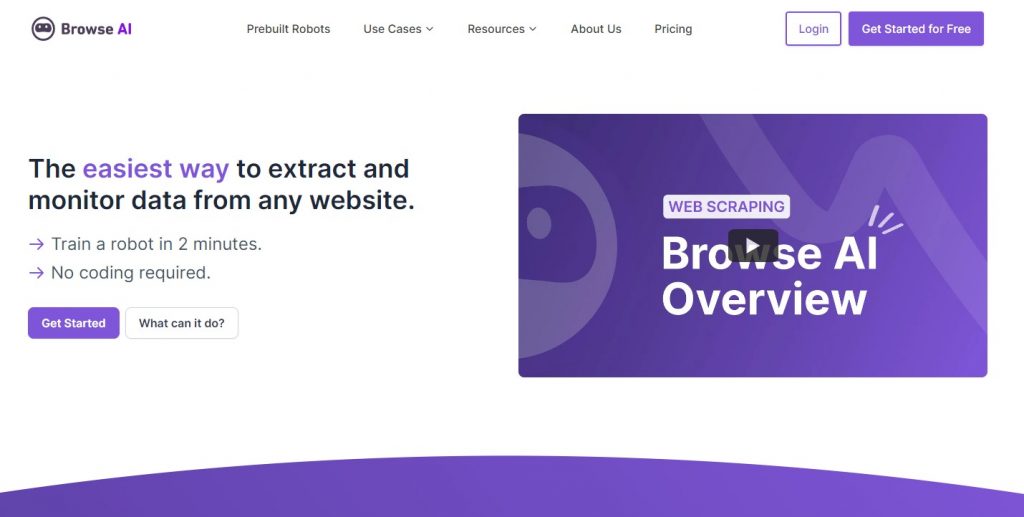
Competitive Intelligence (CI) is one of the most potent weapons in the arsenal of a digital marketer. It allows you to evaluate competition brands as well as identify new trends, pricing plans, reviews, and product debuts. To accomplish CI at scale, you must utilize data scraping, which involves using algorithms (sometimes known as “spiders” or bots) to browse rival sites and extract important data.
Browse AI enables you to easily train a bot to source data for you, instantly populating a spreadsheet with all of the information you want. For example, you may instruct it to hunt for one- or two-star evaluations of competing items in order to identify potential product enhancements or to check the current pricing of similar products on e-commerce sites.
The makers of Browse claim that its AI can mimic human behavior in order to fool Captcha and other bot-spotting safeguards. Over 2500 firms utilize the software, including Adobe, Amazon, Salesforce, and HubSpot.
17. Algolia (for search and recommendation APIs)
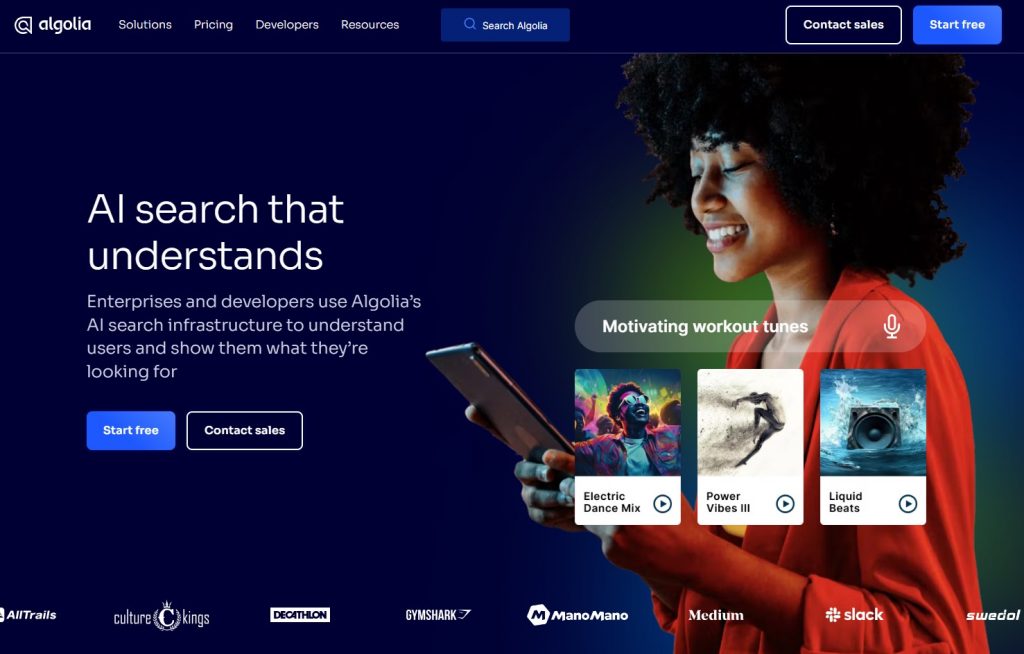
Search fields may be either useful or quite annoying. Rather than including a “powered by Google” box, why not design your own custom search engine?
This is what Algolia provides, which is why it is so popular with entertainment corporations and ecommerce businesses with big inventory. The less time visitors have to waste perusing your catalogue, the more likely they are to purchase from you.
Create your own search filter to help your consumers discover precisely what they’re looking for in record time. Staples, Gymshark, NBCUniversal, Decathlon, Lacoste, and many more companies have already integrated Algolia into their sales sites.
18. PhotoRoom (for removing image backgrounds)

Here’s a useful (and free) specialized program that carefully eliminates the backdrop of any photo, leaving the human subject highlighted on a transparent background that you can use in other images. I tried it with many of my own images and it worked well.
This is a design tool that combines AI and machine learning to recognize and isolate the subject of a photograph from the backdrop. While it used to take a designer 10 minutes to define the shape of a picture, PhotoRoom accomplishes it in seconds. You may also use whatever color backdrop you choose.
It’s a godsend for anyone entrusted with building a “meet the team” website or an avatar to use in various places. There is a premium batch version as well as a mobile app.
19. Reply.io’s AI Sales Email Assistant (for email replies)
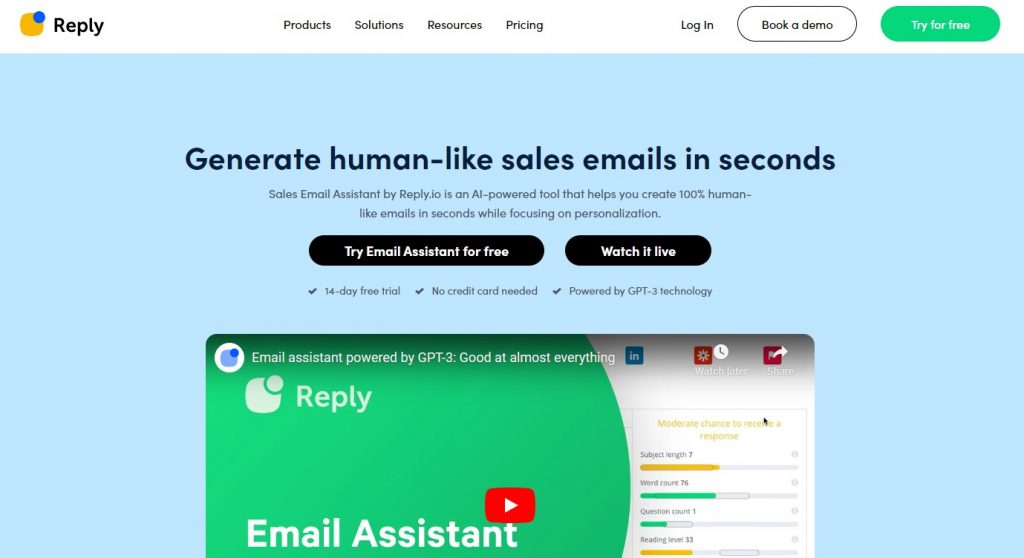
Another marketing chore that may rapidly become boring and labor-intensive is creating standard email answers. Reply.io’s AI Sales Email Assistant attempts to alleviate some of that tedium. However, it offers a wide range of applications and bills itself as a “sales engagement platform.”
While the conversion rate for email marketing efforts may be as low as 1.22%, when scaled up, this can convert to a large number of prospective leads. You’ll need an AI-powered email marketing solution like Reply.io to get the most of this method, which can be totally automated.
Create cold email drip campaigns across several platforms, and Reply will automate the rest, using AI-powered response scoring to find prospective prospects. To track the progress of your campaigns, there are several CRM connections and predictive analytics solutions available.
20. Brand24 (for media monitoring)
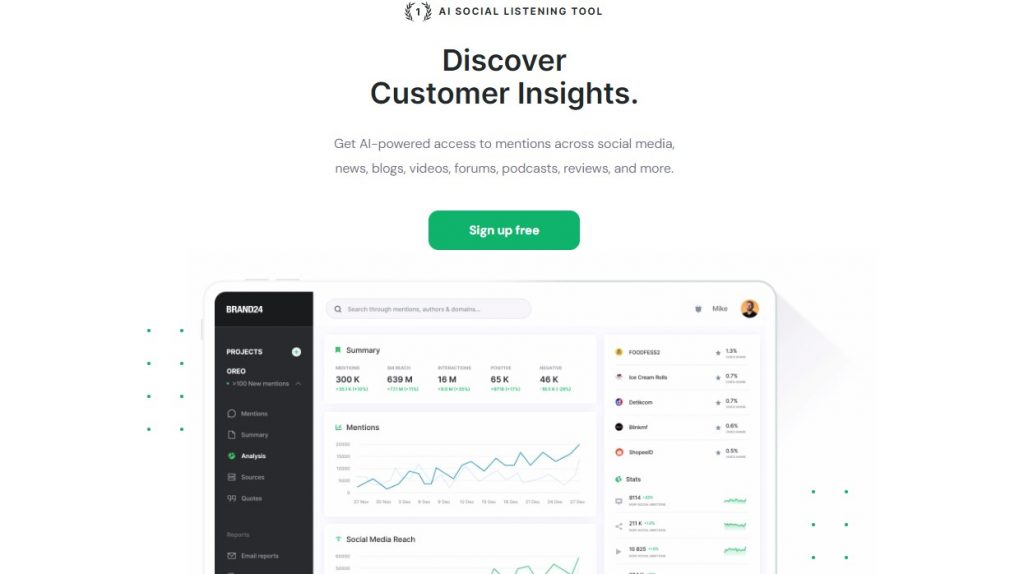
Where do you begin if you want to find out how your brand is being discussed on the internet? Brand24 searches news sites, social media, blogs, forums, videos, and other sites for mentions. It then employs sentiment analysis to discover discussion topics as well as the underlying sentiments of reviewers and users.
You may respond promptly to criticism and engage with customer care issues, increasing client retention and perhaps detecting weaknesses in products and services before they become disasters. Brand24 will highlight problematic references and positive ratings while sifting out irrelevant information far more effectively than a Google keyword search.
There’s an excellent hashtag trend-spotting function, as well as excellent customer assistance, including blogs and masterclasses to help you improve your marketing strategy and customer service abilities. Uber, Stanford University, and Intel are among the clients.
Marketing driven by AI is here to stay.
Given the numerous advantages that AI algorithms may give — scalability, reach, efficiency, cost savings, decision making, analytic capacity, improved customer experience, and so on — it is evident that we are still at the very beginning of this AI technological revolution. Marketers now have access to more innovative tools than ever before, allowing even the smallest startup to compete for global success alongside the most established brands.
Many of the tools mentioned above offer freemium versions, so be open-minded and give them a go; they could become your closest buddy for future marketing endeavors.


Very nice